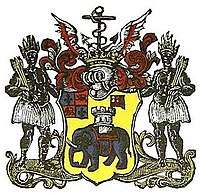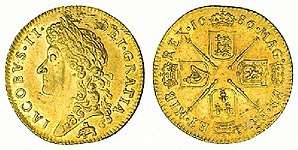Royal African Company
 Coat of arms | |
Formerly | Company of Royal Adventurers Trading to Africa |
|---|---|
| Private | |
| Industry | Mercantile trading |
| Founded | 1660 in London, England |
| Founders | House of Stuart (British Royal Family) |
| Defunct | 1752 |
Key people | James II, Charles II |
| Products | Gold, silver, ivory, slaves |

The Royal African Company (RAC) was an English mercantile (trading) company set up by the Stuart family and City of London merchants to trade along the west coast of Africa. It was led by the Duke of York, who was the brother of Charles II and later took the throne as James II. Its original purpose was to exploit the gold fields up the Gambia River, which were identified by Prince Rupert during the Interregnum. It was established after Charles II gained the English throne in the Restoration of 1660.[1] However, it was soon engaged in the slave trade, as well as with other commodities. It mainly traded with the Gold Coast, which is now Ghana.
History
Originally known as the Company of Royal Adventurers Trading to Africa, by its charter issued in 1660 it was granted a monopoly over English trade with West Africa. With the help of the army and navy, it established forts on the West African coast that served as staging and trading stations and was responsible for seizing any English ships that attempted to operate in violation of the company's monopoly. In the prize court, the King received half of the proceeds and the company half.[2]
The company fell heavily into debt in 1667, during the war with the Netherlands, the very war it had itself started when its Admiral Robert Holmes had attacked the Dutch African trade posts in 1664, as it had lost most of its forts on the African coast except for Cape Corse.[3] For several years after that, the company maintained some desultory trade, including licensing single-trip private traders, but its biggest effort was the creation in 1668 of the Gambia Adventurers,[4] a new company separately subscribed and granted a ten-year licence for African trade north of the Bight of Benin with effect from 1 January 1669.[5] In 1672, the original Company re-emerged, re-structured and with a new charter from the king, as the new Royal African Company. Its new charter was broader than the old one and included the right to set up forts and factories, maintain troops and exercise martial law in West Africa, in pursuit of trade in gold, silver and slaves.[6] At the end of 1678, the licence to the Gambia Adventurers expired and its Gambian trade was merged into the company.[7]
In the 1680s the Company was transporting about 5,000 slaves a year across the Atlantic. Many were branded with the letters "DY", for its Governor, the Duke of York, who succeeded his brother on the throne in 1685, becoming King James II. Other slaves were branded with the company's initials, RAC, on their chests.[8]
Between 1672 and 1689, the Company transported 90,000 to 100,000 slaves . Its profits made a major contribution to the increase in the financial power of those who controlled the City of London.
From 1694 to 1700, the company was a major participant in the Komenda Wars in the port city Komenda in the Eguafo Kingdom in modern-day Ghana. The company allied with a merchant prince named John Cabess and various neighbouring African kingdoms to depose the king of Eguafo and establish a permanent fort and factory in Komenda.[9]
In 1689, the Company acknowledged that it had lost its monopoly with the end of royal power in the Glorious Revolution and it ceased issuing letters of marque.[10] To maintain the company and its infrastructure and end its monopoly, parliament passed the Trade with Africa Act 1697 (9 Will. 3 c. 26),[11] which among other things, opened the African trade to all English merchants who paid a ten per cent levy to the Company on all goods exported from Africa.[12] This development was advantageous for merchants in Bristol even if, like the Bristolian Edward Colston, they had already been involved in the trade. The number of slaves transported on English ships subsequently increased dramatically. The Company continued purchasing and transporting slaves until 1731, when it abandoned slaving in favour of ivory and gold dust.
From 1668 to 1722, the Royal African Company provided gold to the English Mint. Coins made with such gold bear an elephant below the bust of the king and/or queen. This gold also gave the coinage its name, the guinea.[13]
Members and officials
- Charles Hayes (1678–1760), mathematician and chronologer, was sub-governor of Royal African Company until 1752, when it was dissolved.
- Edward Colston was a trader who became a director.
List of notable investors
- Charles II of England
- James Stuart, Duke of York – governor of the RAC from its creation and largest shareholder
- John Locke
- Anthony Ashley Cooper, 1st Earl of Shaftesbury
- Sir Robert Clayton[14]
- Sir Edmund Andros[15]
- Henry Bennet[15]
- earl of Arlington[15]
- George Villiers[15]
- Lord Buckingham[15]
- Sir George Carteret[15]
- earl of Craven[15]
- Lawrence Du Puy[15]
- Ferdinand Gorges[15]
- Lord Francis Hawley[15]
- Thomas Povey[15]
- Prince Rupert[15]
- Sir Joseph Williamson[15]
- Matthew Wren[15]
- Sir Peter Colleton[15]
- Sir John Banks[16]
- Sir Josiah Child[16]
Dissolution
The Royal African Company was dissolved by the African Company Act 1750 with its assets being transferred to the African Company of Merchants. These principally consisted of nine trading posts known as factories: Fort William, Fort James, Fort Sekondi, Fort Winneba, Fort Apollonia, Fort Tantumquery, Fort Metal Cross, Fort Komenda, and Cape Coast Castle, the last of which was the administrative centre.[17]
See also
Notes
- ↑ Carrington, Charles (1950). The British Overseas: Exploits of a Nation of Shopkeepers. Cambridge, England: Cambridge University Press. p. 217. OCLC 1083162.
- ↑ Davies, Kenneth Gordon (1999). The Royal African Company. Routledge/Thoemmes Press. p. 106. ISBN 978-0-415-19077-0. , originally published in London by Longmans, Green in 1957.
- ↑ Zook, George Frederick (1919). The Company of Royal Adventurers Trading Into Africa. Lancaster, Pennsylvania: Press of the New Era Printing Company. p. 20. also published as Zook, George Frederick (1919). "The Company of Royal Adventurers Trading Into Africa". The Journal of Negro History. 4 (2): 134–231, page 155.
- ↑ Sometimes known as The Gambian Merchants' Company.
- ↑ Zook 1919, p. 23
- ↑ Kitson, Frank. (1999) Prince Rupert: Admiral and General-at-Sea. London: Constable, p. 238.
- ↑ Davies 1999, p. 215
- ↑ Micklethwait, John, and Adrian Wooldridge. The Company: A Short History of a Revolutionary Idea. New York: Modern Library, 2003. ISBN 0-679-64249-8.
- ↑ Law, Robin (2007). "The Komenda Wars, 1694–1700: a Revised Narrativ". History in Africa. 34: 133–168. doi:10.1353/hia.2007.0010.
- ↑ Davies 1999, p. 123
- ↑ An Act to settle the Trade to Africa.
- ↑ P. E. H. Hair & Robin Law, 'The English in West Africa to 1700', in The Oxford History of the British Empire: Volume 1, The Origins of Empire: British Overseas Enterprise to the close of the Seventeenth Century, ed. Nicholas Canny (Oxford : Oxford University Press, 1998), p. 259
- ↑ Davies 1999, p. 181
- ↑ Harris, Tim; Taylor, Stephen (2015-10-15). The Final Crisis of the Stuart Monarchy: The Revolutions of 1688–91 in Their British, Atlantic and European Contexts. Boydell & Brewer. ISBN 9781783270446.
- 1 2 3 4 5 6 7 8 9 10 11 12 13 14 15 Pettigrew, William Andrew (2013). Freedom's Debt: The Royal African Company and the Politics of the Atlantic Slave Trade, 1672–1752. UNC Press Books. p. 25. ISBN 9781469611815.
- 1 2 Blackburn, Robin (1998). The Making of New World Slavery: From the Baroque to the Modern, 1492–1800. Verso. p. 255. ISBN 9781859841952.
- ↑ Adams, Robert; Adams, Charles (2005). The Narrative of Robert Adams, A Barbary Captive: A Critical Edition. Cambridge: Cambridge University Press.
|access-date=requires|url=(help)
Further reading
- Davies, Kenneth Gordon. The Royal African Company. Routledge/Thoemmes Press, 1999.
- Pettigrew, William A. Freedom's Debt: The Royal African Company and the Politics of the Atlantic Slave Trade, 1672–1752. Chapel Hill, NC: University of North Carolina Press, 2014.
